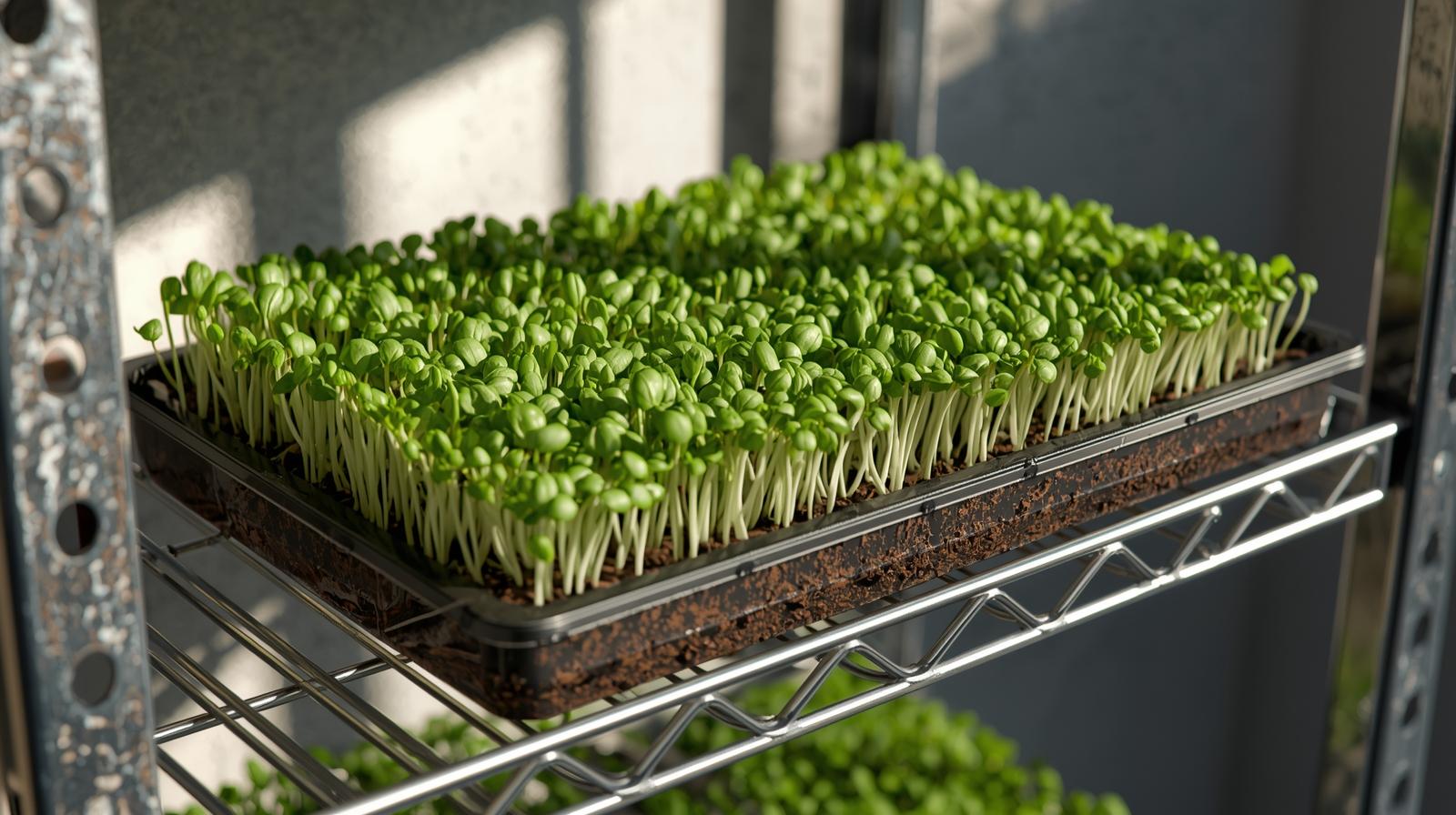Tiny Greens Jam-Packed with Health Benefits and Surprisingly Easy to Grow
Six months ago, I was scrolling through yet another article about gut health when something clicked. Everyone was talking about probiotics, fermented foods, and expensive supplements, but I kept coming across mentions of something simpler: microgreens. These tiny, nutrient-dense greens were being called “superfood babies” and growing microgreens at home seemed almost too good to be true.
What started as curiosity has become one of my most rewarding daily practices. Today, I’m sharing how I discovered microgreens, why they’ve become a cornerstone of my health routine, and how you can start growing them in the most unlikely place your garage , your shed or even on your windowsill

The Gut Health Connection That Changed Everything
Like many of you, I’d been hearing about gut health everywhere. The science is compelling: our gut microbiome affects everything from our immune system to our mood, energy levels, and even our ability to maintain a healthy weight.
But here’s what I learned about microgreens that surprised me: they’re not just nutrient-dense foods, they’re prebiotic powerhouses. While probiotics add beneficial bacteria to your gut, prebiotics feed the good bacteria you already have. Microgreens, especially varieties like broccoli, radish, and pea shoots, are loaded with fibre and compounds that act as premium fuel for your beneficial gut bacteria.
The more I researched, the more excited I became. These weren’t just trendy garnishes they were legitimate nutritional powerhouses that I could grow myself.
Why Microgreens Are Nutritional Superstars
The science behind microgreens is fascinating. Studies have shown that these young plants can contain 4-40 times more nutrients than their mature counterparts. Here’s what makes them so special:
Concentrated Nutrition: When a seed germinates, it packs all the energy and nutrients needed for the plant’s early growth into those first leaves. We’re essentially harvesting plants at their nutritional peak.
Antioxidant Rich: Microgreens are loaded with antioxidants like vitamin C, vitamin E, and beta-carotene. Red cabbage microgreens, for example, contain 40 times more vitamin E than mature red cabbage.
Easy Digestion: Unlike mature vegetables that can be harder to digest, microgreens are tender and easily absorbed by your digestive system.
Variety of Benefits: Different microgreens offer different benefits:
- Broccoli microgreens contain sulforaphane, a powerful compound for detoxification
- Red cabbage microgreens are rich in anthocyanins for heart health
- Pea shoots provide protein and support muscle recovery
- Radish microgreens offer natural antimicrobial properties
The Hidden Nutritional Advantage: Why Soil-Grown Matters
One of the most compelling discoveries in my microgreens journey was learning about the nutritional advantages that only soil-grown microgreens can provide – benefits you simply can’t get from hydroponically grown alternatives.
The Iodine Connection
Growing microgreens in quality soil delivers something most people don’t realize they’re missing: bioavailable iodine. When microgreens grow in mineral-rich soil, they naturally uptake iodine and concentrate it in their leaves. This is crucial because iodine deficiency is surprisingly common, even in developed countries.
Your thyroid depends on adequate iodine for proper hormone production, which affects everything from metabolism to energy levels to brain function. While most people think of seaweed as the primary iodine source, soil-grown microgreens can provide a steady, gentle supply of this essential mineral especially when you’re eating them daily.
This is yet another reason why my garage setup uses organic potting soil rather than hydroponic methods. Those tiny plants are pulling minerals from the earth and concentrating them into every bite.
The Sulforaphane Powerhouse: Broccoli Calabrese Microgreens
Here’s where things get really exciting from a health perspective. Broccoli calabrese microgreens contain up to 100 times more sulforaphane than mature broccoli. Let that sink in 100 times more of one of nature’s most powerful protective compounds.
Sulforaphane is what scientists call a “biological response modifier” it literally helps your body’s cells protect and repair themselves. The research on sulforaphane is staggering:
- Detoxification Support: Activates your body’s natural detox pathways
- Anti-inflammatory: Reduces chronic inflammation at the cellular level
- Neuroprotective: May help protect against cognitive decline
- Cancer Research: Extensively studied for its protective properties
- Heart Health: Supports cardiovascular function
- Cellular Health: Helps cells resist damage from oxidative stress
The key is that sulforaphane is most potent in these young broccoli plants. As the plant matures, the concentration drops dramatically. This means those tiny broccoli calabrese microgreens I’m growing in my garage are delivering therapeutic levels of compounds that would require pounds of mature broccoli to match.
When I add a handful of fresh broccoli microgreens to my morning eggs or lunch salad, I’m not just adding flavor – I’m giving my body a concentrated dose of one of nature’s most researched protective compounds.
The Synergy Effect
What makes this even more powerful is the synergy between the soil-derived minerals like iodine and the plant compounds like sulforaphane. Your body doesn’t process nutrients in isolation – it works with them in combination. When you’re getting both trace minerals from the soil and concentrated phytonutrients from the young plants, you’re supporting your body’s systems in a way that individual supplements simply can’t match.
This is functional nutrition at its finest, and it’s growing right there in my garage.
My Growing Microgreens in the Garage Journey
I never imagined my garage would turn into a mini-farm. But when I saw microgreens selling for £4–6 a container that barely lasted two days, I decided to grow my own.
The garage proved perfect. It stays cool, I control the lighting, and my kitchen counter stays clutter-free. Walking in and seeing rows of vibrant green lifewhere there used to be only storage is incredibly satisfying.
My Simple Setup:
- A few metal shelving units from the hardware store
- LED grow lights (nothing fancy – basic shop lights work great)
- Plastic growing trays with drainage holes
- Organic potting mix
- A variety of seeds: broccoli, radish, pea, sunflower, and red cabbage
The first batch was magical. Watching those tiny seeds transform into vibrant, living food in just 7-14 days felt like witnessing a miracle in fast forward.
The Daily Practice That Compounds
Here’s where the everyday mastery mindset really comes in. Growing microgreens isn’t just about the end product although they are really tasty it’s about the daily practice.
Every morning, I spend 5 minutes in the garage:
- Misting the growing trays
- Checking progress
- Starting new batches
- Harvesting ready greens
This simple routine has become a form of meditation. There’s something grounding about tending to living things, watching incremental daily progress, and literally nurturing growth.
“Starting with just a few trays, this simple daily habit quickly transformed my diet and mindset, echoing the lessons I shared in small habits that rewired my life.”
Small habits that rewired my life
And the metaphor isn’t lost on me: small, daily actions compound into significant change. Just like these tiny seeds become nutrient dense food, our small daily habits become the foundation of our health and wellbeing.

How Growing Microgreens has benefited me so far
Connection to Food: Growing my own food has created a deeper appreciation for what I eat. I know exactly where my greens came from, how they were grown, and when they were harvested – something I never had when everything came from the supermarket.
Daily Ritual: The simple act of tending to something living has become a grounding morning practice. There’s something deeply satisfying about nurturing growth and then literally consuming the fruits of that care.
Seasonal Independence: Having fresh, living food available year-round regardless of weather has been liberating. While the outside world deals with seasonal produce limitations, I have vibrant, fresh greens growing consistently in my garage.
Overall Wellbeing: While it’s hard to pinpoint exactly what’s changed, I feel more balanced overall. Whether it’s the combination of better nutrition, daily ritual, or simply the satisfaction of self-sufficiency, there’s an underlying sense of vitality I didn’t have before.
Beyond the Garage: Growing Microgreens as a Sustainable Practice
What started as a health experiment has become something much bigger. Growing microgreens has connected me to my food in a way I never expected. There’s pride in eating something you’ve grown, satisfaction in the sustainability of it, and joy in sharing fresh greens with friends and family.
Growing Microgreens Philosophy: Small Seeds, Big Changes
The more I work with microgreens, the more I see them as a perfect metaphor for mastery itself. Success isn’t about dramatic overnight changes , it’s about consistent, small actions that compound over time.
Every seed that sprouts reminds me that:
- Growth happens in stages
- Consistency beats intensity
- Small inputs can yield extraordinary outputs
- The process is just as valuable as the outcome
Ready to Start Your Own Growing Microgreens Journey?
If this resonates with you, I’ve created a comprehensive guide to get you started. Whether you have a garage, a sunny windowsill, or just a corner of your kitchen, you can begin growing your own nutritional powerhouses.
Download my free “Garage to Greens: Complete Microgreens Growing Guide” on gumroad here] – it includes everything you need to know:
- Detailed setup instructions for any space
- Best varieties for beginners
- Day-by-day growing timeline
- Troubleshooting common issues
- Recipe ideas for using your harvest
The Compound Effect in Action
Six months ago, I was just someone interested in gut health. Today, I’m someone who grows my own superfood, has a daily practice that grounds me, and has created a sustainable system that supports my health goals.
That’s the power of small, daily growth. Tiny seeds really can create big changes.
The garage (or kitchen counter) is waiting. Your gut health is waiting. Your daily practice is waiting.
What small seed will you plant today?
Ready to transform your health one microgreen at a time? Download the free guide and start your 7-day microgreen challenge. Small daily actions, extraordinary results.
What’s your experience with gut health and growing your own food? Share in the comments below – I’d love to hear your story!
Kel is the writer behind Everyday Mastery, where she shares the real, messy, and meaningful process of building habits, resilience, and self-belief from the ground up. Her writing blends ancient philosophy with modern science, always focused on small, practical steps that lead to lasting